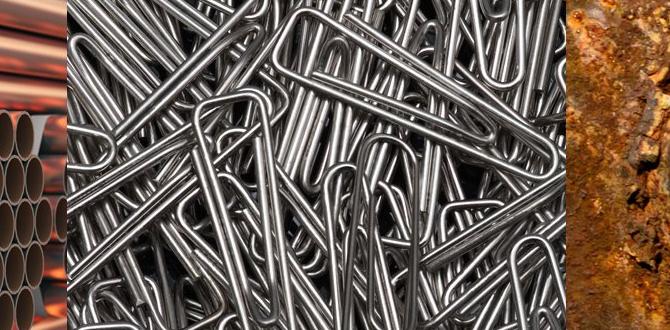A TIALN ball nose end mill is a game-changer for roughing Inconel 718, offering superior performance, extended tool life, and smoother cuts. Its specialized coating and geometry are specifically designed to tackle the challenges of this tough-to-machine superalloy, making your roughing operations more efficient and less frustrating.
Machining tough materials like Inconel 718 can feel like wrestling a bear. It’s hard, it’s unforgiving, and it can chew up tools faster than you can buy them. If you’ve ever struggled with roughing Inconel 718, you know the frustration of slow progress, tool breakage, and subpar surface finishes. But what if there was a specific tool that made this whole process significantly easier? That’s where the TIALN ball nose end mill comes in, especially when it’s designed for roughing. We’re going to explore exactly why this tool is such a brilliant choice for tackling Inconel 718 and how you can use it to get great results, even if you’re new to machining this challenging material. Get ready to make your Inconel 718 roughing jobs fly!
Understanding Inconel 718: Why It’s a Machining Beast
Before we dive into why a TIALN ball nose end mill is so great for Inconel 718, let’s quickly touch on why this material is so notoriously difficult to machine. Inconel 718 is a nickel-based superalloy, meaning it’s designed for extreme environments – think jet engines, rocket motors, and nuclear reactors.
Here’s what makes it tough:
- High Strength and Hardness: It maintains its strength and hardness even at elevated temperatures, which also happen to be generated during machining. This means the material resists cutting forces and work hardens easily.
- Low Thermal Conductivity: Inconel 718 doesn’t dissipate heat well. This means the heat generated by friction during cutting stays concentrated at the cutting edge, rapidly dulling tools and leading to thermal damage.
- Galling Tendencies: It has a tendency to “gall” or weld itself to the cutting tool. This can cause built-up edge (BUE) on the tool, leading to poor surface finish and premature tool failure.
- Work Hardening: As you cut into it, the area you just cut becomes even harder, making subsequent passes more difficult for the tool.
These properties mean that standard tooling and machining practices often fall short when working with Inconel 718, especially during roughing operations where material is removed quickly and aggressively. You need specialized solutions to get the job done efficiently and without breaking the bank on broken tools.
What is a Ball Nose End Mill?
A ball nose end mill, often called a “ball end mill,” is a type of rotary cutting tool used in milling operations. Unlike flat-ended end mills, its cutting end is shaped like a hemisphere – a perfect ball.
Here’s what makes it unique:
- Full Radius Tip: The tip of the tool is a complete radius.
- Multiple Cutting Edges: It typically has two or more flutes (cutting edges) that extend from the side of the tool all the way to the center of its spherical tip.
- Versatile Geometry: Because of its shape, it’s ideal for creating curved surfaces, contours, and pockets. It can plunge directly into material like a drill (though not as effectively as a dedicated drill) and mill in any direction.
For roughing Inconel 718, a ball nose end mill offers an advantage because its rounded geometry can help distribute cutting forces more evenly compared to a sharp-cornered tool, which can be beneficial for reducing stress on the tool and workpiece. This is especially true for the specific geometries needed when roughing out complex Inconel parts.
The Magic of TIALN Coating for Inconel 718
Now, let’s talk about the “TIALN” part. TIALN stands for Titanium Aluminum Nitride. It’s not just a fancy name; it’s a high-performance PVD (Physical Vapor Deposition) coating that significantly enhances the capabilities of an end mill, especially for tough materials like Inconel 718.
Here’s why TIALN is a superhero for Inconel 718:
- Exceptional Hardness: TIALN is incredibly hard, which means it resists abrasion exceptionally well. This is crucial for Inconel 718, which can act like sandpaper on cutting tools.
- High-Temperature Stability: Crucially, TIALN coatings can withstand very high temperatures without losing their hardness or structural integrity. As we discussed, Inconel 718 generates a lot of heat during machining. This coating forms a protective barrier that prevents the cutting edge from getting excessively hot, reducing the risk of thermal softening and chipping.
- Low Coefficient of Friction: The coating helps reduce friction between the tool and the workpiece. Less friction means less heat generation and less tendency for the Inconel to gall or stick to the tool.
- Oxidation Resistance: TIALN has excellent resistance to oxidation at high temperatures, further protecting the tool from degradation.
When you combine the geometry of a ball nose end mill with the protective and performance-enhancing properties of a TIALN coating, you create a tool that’s specifically engineered to conquer the challenges of roughing Inconel 718.
Why a TIALN Ball Nose End Mill is Genius for Inconel 718 Roughing
So, why is this specific combination – a TIALN coating applied to a ball nose end mill – and the task of roughing Inconel 718 such a perfect match? It boils down to addressing Inconel 718’s inherent difficulties with a tool’s specialized design.
Here’s the genius behind it:
-
Combating Heat: Inconel 718 generates immense heat. The TIALN coating creates a thermal barrier, allowing the tool to cut at higher speeds and feeds without overheating as quickly. This is vital for efficient roughing.
-
Fighting Hardness and Wear: Inconel is hard, and it makes tools wear fast. The extreme hardness of the TIALN coating means it resists this abrasive wear much better than uncoated carbide or even other coatings. You get more parts out of a single tool.
-
Reducing Galling: Galling is a major problem with Inconel; material sticks to the tool, ruining the cut and often breaking the tool. The slick surface of the TIALN coating and its reduction in friction significantly minimize this sticking tendency.
-
Optimized Chip Formation for Roughing: While ball nose end mills can be used for finishing, when designed for roughing, they often have specific flute geometries (like more aggressive helix angles or chip-breaker features) and a robust carbide substrate. The ball nose shape itself, when used for roughing, can manage material removal in a way that is less prone to shock loading compared to a square end mill with a sharp corner, especially in challenging geometries. It allows for effective material removal while being slightly more forgiving on the tool.
-
Versatile Material Removal: A ball nose end mill, even in a roughing configuration, can create 3D shapes and contours. This is invaluable when you’re not just taking large, flat cuts but roughing out complex internal features or 3D parting lines often found in aerospace parts made from Inconel 718.
-
Increased Productivity: Because the tool lasts longer, cuts more efficiently, and reduces the risk of catastrophic failure, your overall machining time decreases, and your throughput increases. This is a huge win for any shop.
-
Improved surface finish (for Roughing): While not a finishing tool, a properly applied TIALN ball nose end mill for roughing will leave a much better surface finish than a struggling, dull tool. This means less work for subsequent finishing passes, saving more time and effort.
When you factor in that many specialized TIALN ball nose end mills for Inconel 718 might also have specific flute counts (often 3 or 4 flutes for stability and chip evacuation in tougher materials), corner radii optimized for strength, and a robust substrate, you have a tool that is truly a “genius” solution for this challenging material.
Key Features to Look For in a TIALN Ball Nose End Mill for Inconel 718 Roughing
Not all TIALN ball nose end mills are created equal, especially when tasked with the beefy job of roughing Inconel 718. Here are the key features you should be on the lookout for to ensure you’re getting a tool built for success:
| Feature | Why It Matters for Inconel 718 Roughing |
|---|---|
| Coating: TIALN (Titanium Aluminum Nitride) | Essential for high-temperature stability, extreme hardness, and reduced friction, directly combating Inconel’s heat and galling issues. |
| End Mill Type: Ball Nose | Provides a rounded profile ideal for smooth material removal in contoured areas and a strong, shock-absorbing tip ideal for less-than-perfect setups or less rigid machines. |
| Substrate Material: High-Quality Carbide (e.g., Sub-Micron Grain) | Provides the underlying strength and wear resistance needed to support the coating when subjected to the extreme forces of cutting Inconel. |
| Number of Flutes: Usually 3 or 4 | More flutes generally allow for a larger core diameter (strength) and better chip evacuation in tougher materials. Fewer flutes might generate less heat, but 3-4 offer a good balance for roughing. |
| Helix Angle: Medium to High (e.g., 30-45 degrees) | A higher helix angle provides a more shearing cut, reducing cutting forces and heat. However, very high angles can reduce rigidity. A balanced angle is key for Inconel. |
| Corner Radius: Optimized for Strength | A defined corner radius adds strength at the tip compared to a perfectly sharp corner, reducing chipping risk. The radius size will depend on the specific application and tool design. |
| Chip Breakers/Gashers: Often Present | Some roughing end mills incorporate features on the cutting edges to break chips into smaller, more manageable pieces, preventing recutting and improving chip evacuation. |
| Overall Robustness: Heavier Core Diameter | A tool with a thicker core diameter is more resistant to bending and breakage under heavy roughing loads. |
Setting Up for Success: CNC Parameters and Best Practices
Using a high-performance tool like a TIALN ball nose end mill is only half the battle. The other half is setting your machine and parameters correctly. Here’s a breakdown of what you need to know:
1. Machine Rigidity and Workholding
Inconel 718 creates significant cutting forces. Your machine needs to be rigid enough to handle this. A wobbly machine or a poorly held workpiece will lead to chatter, tool breakage, and poor finishes.
- Rigid Machine: Ensure your milling machine (even a small benchtop one, if suitable) is well-maintained and free of excessive play in the axes.
- Secure Workholding: Use a robust vice, clamps, or fixture that firmly holds the Inconel 718. Avoid any movement of the workpiece during the cut. For complex parts, consider a fixture designed specifically for the job.
You can find excellent resources on workholding principles from organizations like Manufacturing Engineering Magazine, which often cover best practices for securing challenging materials.
2. Cutting Fluid and Lubrication
Cooling and lubrication are paramount when machining Inconel 718. You need something that can handle the high temperatures.
- Flood Coolant: A high-pressure flood coolant system is ideal. It helps flush chips away, cools the cutting edge, and lubricates the cut.
- Synthetics or Semi-Synthetics: Look for cutting fluids specifically designed for high-temperature alloys. They often contain extreme pressure (EP) additives.
- Through-Spindle Coolant: If your machine has through-spindle coolant, ensure the nozzles are aimed directly at the cutting edge where the tool meets the workpiece.
- Mist Coolant: While less effective than flood for heavy roughing, a high-quality mist coolant system can provide some relief.
Consulting your cutting fluid manufacturer’s recommendations for Inconel 718 is always a good idea.
3. Machining Parameters (Speeds and Feeds)
This is where you’ll see the biggest difference. Because Inconel 718 is so tough, typical mild steel parameters won’t work. You need to find the sweet spot that balances material removal rate with tool life.
General Guidelines for TIALN Ball Nose End Mills in Inconel 718 Roughing:
| Parameter | Typical Range | Notes |
|---|---|---|
| Surface Speed (SFM) | 25 – 70 SFM | This is a starting point. Lower end for heavier cuts/less rigid setups, higher end for lighter cuts/more rigid machines. TIALN allows for the higher end of this range. |
| Cutting Feed Rate (IPM) | 0.002 – 0.005 IPT (per tooth) | Depends heavily on the tool diameter and number of flutes. Larger diameter = higher IPM. Always aim for a chip load that produces a good chip. Start conservatively. |
| Spindle Speed (RPM) | (Surface Speed * 3.82) / Diameter (inches) | Calculate based on your desired SFM and tool diameter. |
| Depth of Cut (DOC) | 0.050″ – 0.250″ (or more) | For roughing, aim for a significant depth of cut, but monitor for chatter. This depends heavily on tool diameter and rigidity. |
| Width of Cut (WOC) | 10% – 50% of tool diameter | For efficient material removal, especially in 3D contouring. |
| Engagement Angle (for milling operations) | N/A for full ball nose plunge; use appropriate step-over. | When milling with the side of the ball nose, aim for shallow engagement angles (e.g., 5-10% radial stepover). |
Important Considerations:
- Start Conservatively: Always begin with the lower end of these ranges and gradually increase them while monitoring the cut, sound, chip formation, and surface finish.
- Chip Load is Key: Aim for a chip thickness (chip load) that is appropriate for the tool and material. Too thin a chip means rubbing; too thick means overloading the tool. The TIALN ball nose roughing end mill is designed to handle adequate chip loads.
- Tool Manufacturer Recommendations: Consult the specific recommendations from the tool manufacturer. They often provide detailed parameters for Inconel 718.
- Test Cuts: If possible, perform test cuts on a scrap piece of Inconel 718 to dial in your parameters before machining your critical part.
For more in-depth information on machining parameters, resources like Sandvik Coromant’s Machining Calculator can provide excellent starting points and offer insights into tool life calculations.
4. Tool Path Strategy
Even with a great tool, how you move it matters.
- Avoid Full Width Engagement: For general milling, use a radial stepover that is a fraction of the tool diameter (e.g., 10-30%) to reduce cutting forces when milling with the side of the ball.
- Smooth Transitions: Program smooth, continuous tool







